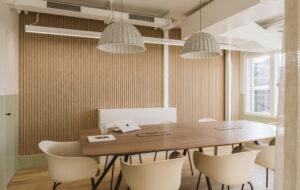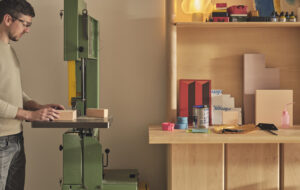 |||||||||||||
|||||||||||||
Cartwright Pickard Architects describe its latest building, XYZ Spinningfields in Manchester, as a “speculative office”. There are ongoing discussions about enhancing efficiency in the workplace by designing more adaptable spaces, but often it’s difficult to visualise how such flexibility is achieved. “What became increasingly evident was that informed businesses across multiple sectors were all attracted by the same desire to support health and wellbeing within their staff with the ultimate goals being to prevent churn and improve productivity amongst a millennial workforce,” associate director Ross Ogilvie explains. “Creating an exciting and dynamic building goes some way to answer both of these concerns.”
For the architects, the solution was to develop a “business community” – in other words, a dynamic environment empowering both people and businesses. The building itself encourages collaboration between companies, whether these are located inside XYZ or in the wider neighbourhood. Situated on a narrow linear site along a major walkway, the building straddles a pedestrian line extending from Salford Central station to the central business district, contributing to the integration of the building within the broader Spinningfields area. Simultaneously, XYZ includes “moments of architectural delight and drama in areas to promote impromptu social and work interaction” – the difficulty was to ease communication at a human scale and at a corporate scale at the same time.
The key lay in giving both people and businesses a sense of control, as making tenants feel more comfortable in a space in turn improves their work performance. Architecturally, this is achieved through a modular system, which can be reconfigured to suit various needs. “A successful framework building is one that allows its tenants to customise their ownership or brand onto their space while providing sufficient spatial and programmatic cohesion that fosters a community,” says Ogilvie. From the exterior, the project is characterised by a highly regularised facade that helped the design team accomplish the flexibility their client was striving for. “The programmatic requirements informed the repetitive facade bay,” points out Ogilvie, emphasising Cartwright Pickard’s approach to the prompt and the architects’ decision to let program dictate the building’s external appearance.
Although the overall goal was clear, the process proved tricky. “The challenge with designing such a flexible office environment meant we began to a certain extent designing from the inside out,” admits Ogilvie. But the team selected elements based on their ability to perform multiple tasks, augmenting the building’s capabilities – Ogilvie names the example of concrete, as the material serves structure, fire, acoustic, environmental and aesthetic roles. Despite the uniformity of the facade, the architects included dramatic elements. Features such as a large spiralling staircase are intended to prompt social interactions so as to avoid repetitiveness, inspire conversations and generate ideas, confirming that architecture can make the office a better place.
Architects aimed to create an office that would help retain staff and improve wellbeing and productivity
























